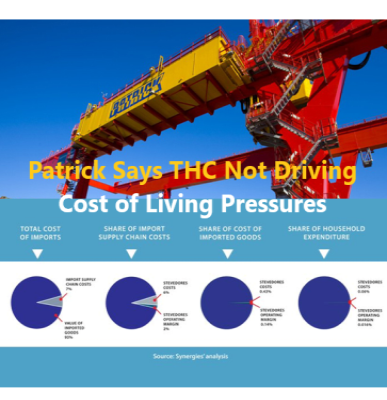Patrick Terminals has issued a Media Statement: “Synergies Analysis Confirms Container Terminal Charges are not a driver of Cost of Living pressures.”
On X (Twitter) they posted:
“Patrick Terminals @PatrickTerminal Aug 19
Synergies Analysis Confirms: Container Terminal Charges Aren’t Driving Cost of Living Pressures. Stevedore margins add just $0.40/week (0.016%) to household expenses. Supply chain costs are down 50% in 20 years.”
Industry representative body, Freight & Trade Alliance (FTA)/Australian Peak Shippers Association (APSA) has been quick to point out that the timing of the Patrick media release is in the lead up to the next Australian Competition and Consumer Commission (ACCC) Stevedore Monitoring Report (scheduled for November 2024) which the Federal Treasurer has indicated in media statements will be key as a part of the government’s consideration for regulatory intervention.
In their media statement, Patrick Terminals, expressed concern at recent political and media commentary that increases in container terminal charges have contributed to the cost-of-living pressures. Their claims are reflected in these three extracted paragraphs:
“Recent analysis completed by Synergies Economic Consulting observes that the operating margin of stevedores contributes approximately $0.40 per week (0.016%) to average household expenditure, an amount that cannot be credibly maintained to have an effect on cost-of-living pressures.”
“Synergies modelling also identifies that overall import supply chain costs have reduced by around 50% in real terms over the last two decades and that it is investment by container terminal operators that has made an important contribution to this reduction.”
“The Synergies report concludes that it is misleading to suggest that cost-of-living pressures can be alleviated by intervening in the market for container terminal services.”
FTA/APSA has responded in a public letter, which is available on their website, and these extracts sum up their differing view on the matter:
“In response, and as evidenced in consecutive Australian Competition and Consumer Commission (ACCC) Stevedore Monitoring Reports, stevedores have reduced quayside revenue and are self-compensating (some may argue profiteering) with increases in landside rates via TACs; a charge that transport operators, freight forwarders, importers and exporters cannot negotiate and are pure price takers.”
“Data received by FTA and APSA suggest daily storage rates charged back to shipping lines are negligible, leaving the empty container parks with little option but to also deploy a model with charges administered via their vehicle booking systems; again, a charge that transport operators, freight forwarders, importers and exporters cannot negotiate and are pure price takers.”
“FTA and APSA have provided detailed evidence to the ACCC and federal government ministers that the collective charges across Australian empty container parks and stevedores are more than $1 billion per year.”
“The result is foreign owned shipping lines are benefitting from a reduction in quayside charges with most maintaining or increasing Terminal Handling Charges. FTA and APSA are exploring avenues as to how to achieve more transparency in how shipping lines derive this charge. In the interim, the shipping lines are the clear winners with a windfall contributing to their ongoing multi-billion-dollar profits.”
FTA’s challenge is very clear from the heading of their report: “Terminal Access Charges debate ramps up – Let the Games begin!!” FTA and APSA say they will continue to report on further developments.
Also see our article from earlier this year: Container Terminal Challenges as 2024 Starts
For the latest information about shipping and stevedoring, talk to here at Colless Young. As licensed Customs Brokers and Freight Forwarders we offer correct, professional advice on all your transportation requirements. We are based in Brisbane and provide a complete range of logistics services, both airfreight and sea cargo, through all Australian ports and airports.

